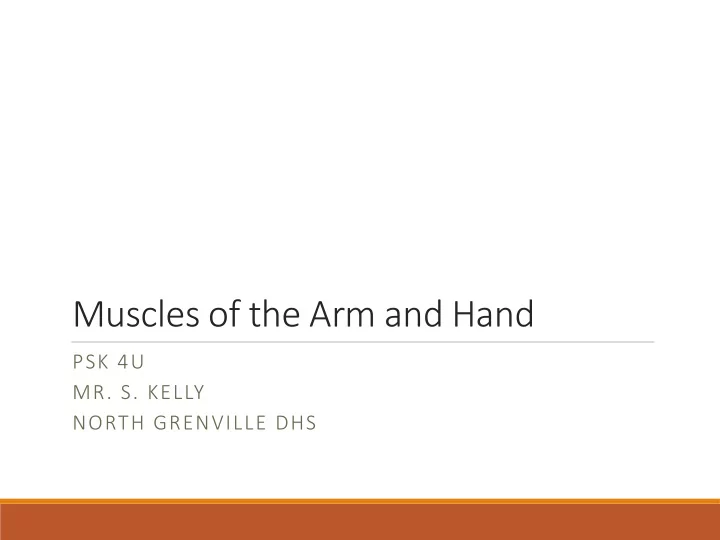

Muscles of the Arm and Hand PSK 4U MR. S. KELLY NORTH GRENVILLE DHS
Biceps Brachii Origin: scapula Insertion: radius, fascia of forearm (bicipital aponeurosis) Action: supination and elbow flexion Innervation: musculocutaneous
Brachialis Origin: humerus Insertion: ulna Action: elbow flexion (assists biceps brachii by instigating this movement) Lies deep to biceps brachii Innervation: musculocutaneous, radial
Triceps Brachii (long, medial, and lateral heads) Origin: scapula and posterior humerus Insertion: proximal posterior ulna Action: elbow extension; shoulder extension and adduction (when elbow is extended) Innervation: axillary, radial
Forearm Muscles: acting on elbow, wrist, and finger joints FLEXOR-PRONATORS EXTENSOR-SUPINATORS Originate via a common flexor Originates via common extensor tendon from medial epicondyle of tendon from lateral epicondyle of humerus (common flexor origin) humerus (common extensor origin)
More on the Forearm 3 layers of muscles: deep, intermediate, and superficial A layer of fascia separates deep layer of muscles from intermediate and superficial Flexor retinaculum, aka transverse carpal ligament: roof of the carpal tunnel Flexor tendons and median nerve pass through the carpal tunnel FR increases effectiveness of tendons by preventing bowstringing, changing direction of forces when necessary
Supinator Origin: lateral epicondyle of humerus, ulna, radial collateral ligament Insertion: proximal 1/3 of radius Action: prime mover in supination of forearm (aided by biceps brachii)
Pronators PRONATOR QUADRATUS PRONATOR TERES Origin: distal anterior ulna Origin: common flexor tendon, proximal ulna Insertion: distal anterior radius Insertion: lateral radius Action: prime mover in pronation of the forearm (assisted by Action: pronation of forearm, pronator teres) weak elbow flexor Innervation: median Innervation: median
Pronators
Flexor Digitorum Profundus Origin: ulna, interosseus membrane Insertion: phalanges, after penetrating tendons of FDS Action: flexes fingers 1-4 Innervation: anterior interosseus, ulnar
Flexor Policis Longus Origin: radius, interosseus membrane Insertion: distal phalanx of thumb Action: thumb flexion FPL is unique to humans: not present (or does very little) in other primates
Flexor Digitorum Superficialis Origin: ulnar collateral ligament of elbow, CFO Insertion: intermediate phalanges of 4 fingers Action: flexes PIP, MP, wrist joints Innervation: median
Palmaris Longus Absent in about 14% of population Absence does not affect grip strength Disadvantage: absence means lack of popular source for tendon graft Test: touch pads of thumb and 5 th finger + flex wrist… 2 or 3 tendons?
Brachioradialis Origin: lateral humerus Insertion: styloid process of radius Action: a flexor that also works to pronate AND supinate (in supination, it pronates as it flexes, and vice versa) Innervation: median
Abductor Policis Longus Origin: ulna, radius, interosseus membrane Insertion: 1 st metacarpal, trapezium, abductor policis brevis tendon Action: abduction of thumb, keeps trapezium stable with APB Innervation: radial
Extensor Digitorum Originates on lateral epicondyle Inserts on medial 4 digits Extends phalanges and wrist joint Insertion splits on 4 digits to medial and lateral sides.
Anatomical Snuff Box Extensor policis longus tendon (posterior border) Anterior (lateral) border: extensor policis brevis and abductor policis longus Skeletal components: scaphoid and trapezium Importance: blood supply of scaphoid is retrograde, therefore proximal fractures require attention to prevent necrosis Name: comes from the practice of placing powdered tobacco on this surface for sniffing. Don’t ask why… almost sounds as stupid as vaping, no? Significance (other than arcane tobacco practices): pain and tenderness in this area are often indicative of scaphoid or other carpal fractures.
Anatomical Snuff Box borders
Primary Hand Grip Muscles (identification only)
Recommend
More recommend